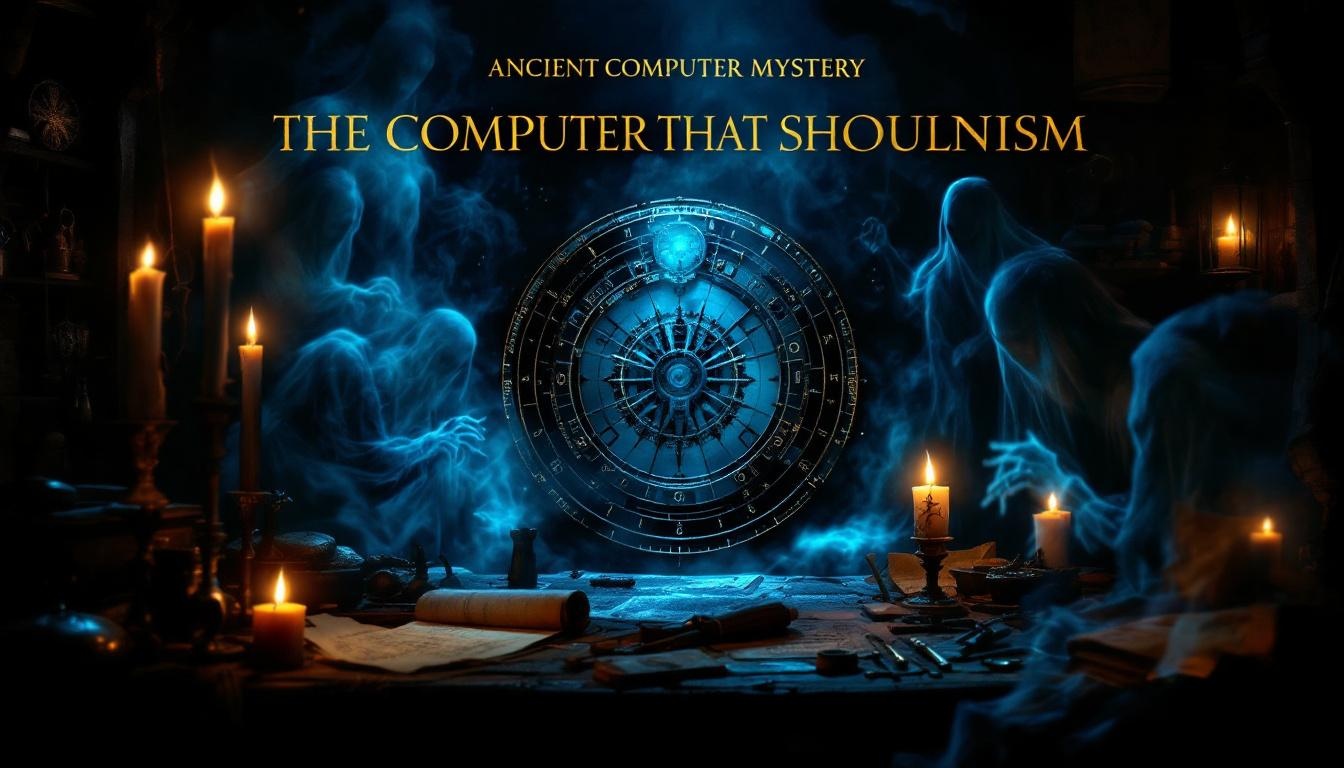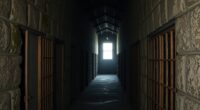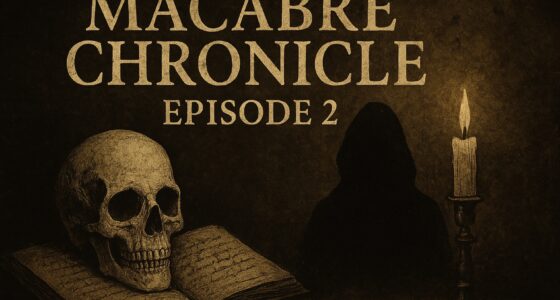Imagine discovering that the most terrifying stories from your worst nightmares actually happened to real people throughout history. Tonight, we’re examining twenty documented historical events that prove reality can be far more horrifying than any fictional horror film. You’ll hear about an isolated German farmhouse where a killer lived among corpses for days, a perfectly preserved ship found drifting empty across the Atlantic, and pioneers trapped in mountain snow who faced unthinkable choices to survive.
These aren’t urban legends or ghost stories passed down through generations. These are meticulously documented tragedies, mysterious disappearances, and unexplained phenomena grounded in court records, forensic analyses, and eyewitness accounts. Each case will challenge what you thought you knew about the limits of human experience, and at least one will defy every rational explanation you can imagine.
The Hinterkaifeck Murders – Germany’s Most Disturbing Unsolved Case
Our first case begins on March 31, 1922, when neighbors discovered a trail of footprints in the snow leading from the dark Bavarian forest directly to Andreas Gruber’s isolated farmhouse at Hinterkaifeck. These weren’t the familiar boot prints of family members. Someone had walked from the woods to their door.
For weeks before this discovery, the Gruber family had lived in growing terror. Strange footsteps echoed from their attic at night. House keys vanished without explanation. An unfamiliar newspaper appeared on their property, though no one had delivered it. Andreas found footprints in his barn that didn’t match anyone in the household. The family’s maid had quit abruptly, claiming the farmhouse was haunted.
Four days after the murders, neighbors finally entered the home. Six members of the household lay dead, along with the new maid who had arrived just hours before the killings. All had been killed with a mattock farming tool.
What investigators discovered next defied explanation. Someone had remained on the farm after the murders, calmly feeding the livestock, eating meals in the kitchen, and even lighting fires to stay warm. The killer had lived among the corpses. No one was ever convicted. The farm’s silence kept its final secret.
But Germany’s unsolved mysteries pale beside what sailors discovered drifting in the Atlantic decades earlier.
The Mary Celeste – Ghost Ship Found Perfectly Preserved
On December 4, 1872, the crew of the merchant vessel Dei Gratia spotted something unsettling near the Azores islands. A ship drifted silently through the Atlantic swells, its sails partially set but moving without purpose or direction. This was the Mary Celeste, and what they found aboard would become maritime history’s most enduring mystery.
The boarding party discovered a vessel frozen in time. The cargo of denatured alcohol remained untouched and properly secured. Personal belongings sat exactly where their owners had left them. Half-eaten meals lay abandoned on tables. The captain’s log ended abruptly nine days earlier with no indication of distress or danger. Yet every soul aboard had vanished without explanation.
Evidence pointed to hasty abandonment. The ship’s lifeboat was missing, suggesting the crew had deliberately left their vessel. But the Mary Celeste showed no storm damage and contained plenty of food and fresh water for weeks of sailing.
Investigators proposed theories ranging from piracy to sudden evacuation due to fears of cargo explosion, but none explained all the evidence. The ship remained seaworthy, showed no signs of violence, and offered no clues about why ten people would abandon a perfectly functional vessel in the middle of the ocean.
Yet this maritime mystery would pale beside the horrors that awaited American pioneers venturing west.
The Donner Party – Survival Cannibalism in the Sierra Nevada
In July 1846, eighty-seven pioneers made a decision that would haunt American history. Led by promises from Lansford Hastings, they chose his untested cutoff route, believing it would save four hundred miles on their journey to California. Hastings had promoted this shortcut without proper testing, and it proved to be a deadly lie that actually lengthened their journey by crucial weeks.
By late October, the travelers realized the Hastings Cutoff had added time instead of saving it. Winter weather arrived early in the Sierra Nevada mountains, and their food supplies ran dangerously low. Snow began falling as they reached Truckee Lake, trapping the families in makeshift shelters through the brutal winter months.
As weeks turned to months, starvation transformed ordinary people into desperate survivors. When family members died from exposure and hunger, the living faced an unthinkable choice. They began consuming the flesh of their deceased companions to stay alive.
Relief parties who finally reached the camps in early 1847 discovered scenes that traumatized even hardened mountain men. Survivors had been reduced to skeletal figures, bearing psychological scars that would last lifetimes. Only forty-eight of the original eighty-seven pioneers survived this winter, creating America’s most documented case of survival cannibalism.
Yet even this documented tragedy would seem rational compared to what archaeologists would soon uncover in an ancient Egyptian tomb.
The Curse of King Tutankhamun’s Tomb
On November 26, 1922, Howard Carter peered through a small hole into King Tutankhamun’s burial chamber and whispered his famous words when asked what he could see: “Wonderful things.” This moment launched one of archaeology’s greatest discoveries and its most terrifying curse.
Lord Carnarvon, the expedition’s wealthy financier, died just five months after the tomb’s opening. An infected mosquito bite on his cheek led to blood poisoning and pneumonia. At the exact moment of his death in Cairo, the city’s power grid failed completely. His dog back in England reportedly howled and died at the same time.
The coincidences piled up with disturbing frequency, and public opinion quickly turned to the idea of a curse. Carter’s personal secretary died suddenly from apparent heart failure. The radiologist who X-rayed Tutankhamun’s mummy collapsed and died shortly after completing his work. Several visiting archaeologists and expedition members followed within months, their deaths occurring under strange circumstances that defied medical explanation.
Even Arthur Conan Doyle publicly attributed these deaths to supernatural forces, lending scientific credibility to curse theories. Statistical analysis later revealed that expedition members died at rates far exceeding normal life expectancy for their age group. The analysis raised questions but could not prove supernatural causation, leaving the mystery unsolved.
Yet Egypt’s unexplained deaths would pale beside what happened when mass hysteria seized an entire European city.
The Dancing Plague of 1518 – Mass Hysteria Turned Deadly
July 1518 brought an outbreak that would challenge everything medical authorities thought they understood about human behavior. A woman named Frau Troffea stepped into the narrow streets of Strasbourg and began to dance. She moved with frantic, uncontrolled motions that continued without pause through the scorching summer day and into the night. Her feet bled, but she could not stop moving.
Within days, dozens of citizens joined her compulsive dancing. The affliction spread like wildfire through the city’s population. Soon, hundreds of people danced in the streets with wild, jerking movements that continued day and night without rest. Their faces showed terror and exhaustion, but their bodies would not obey their minds.
The city authorities made a catastrophic decision. They hired musicians and constructed wooden stages, believing the dancers needed to exhaust themselves completely to break free from their condition. This only intensified the frenzy.
Dancers began collapsing from heart attacks, strokes, and sheer exhaustion. Yet even as they died, their limbs continued twitching in rhythmic motions. Medical experts now propose theories ranging from ergot poisoning from contaminated grain to mass psychogenic illness triggered by religious extremism and social stress. Ergot is a fungus known to contaminate grain and cause convulsions.
Psychogenic illness can spread rapidly in high-stress, religious contexts. This documented outbreak proves that psychological contagion can become literally fatal, and that official responses can amplify mass panic rather than contain it.
While mass hysteria claimed lives in medieval streets, modern dangers would prove equally unforgiving in confined spaces.
The Nutty Putty Cave Incident – Trapped Upside Down for 28 Hours
November 24, 2009 began as a routine family outing for twenty-six-year-old John Edward Jones. He entered Utah’s Nutty Putty Cave with his brothers and friends, planning a casual exploration of the limestone passages he had visited many times before. The cave’s narrow tunnels were familiar territory for experienced cavers.
Around 8 PM, Jones made a fatal navigation error. He mistook an unmapped passage for the route to his favorite chamber and squeezed headfirst into what appeared to be a tight but manageable crawlway. The eighteen-inch-wide crevice angled sharply downward, and gravity pulled his body deeper into the rock formation until he became completely wedged upside down.
Rescue teams worked for twenty-eight hours straight, deploying complex pulley systems and drilling equipment in desperate attempts to extract Jones from his rocky prison. His inverted position prevented proper blood circulation and made breathing increasingly difficult as hours passed. At a certain point, crews recognized that their extraction attempts were causing further injury to Jones’s trapped body.
Despite heroic efforts involving dozens of volunteers, rescuers eventually realized continued pulling would prove fatal. Jones died trapped in the cave, which was permanently sealed with concrete. His body remains entombed in the Utah mountainside.
Yet even this modern tragedy would pale beside what nineteenth-century sailors faced when nature itself turned predator.
The Essex Whale Attack – Real Story Behind Moby Dick
On August 12, 1819, the whaleship Essex departed Nantucket Island with twenty crew members expecting a routine two-year hunting expedition in the Pacific. Captain George Pollard Jr. commanded an experienced crew aboard a sturdy vessel designed for the dangerous but profitable business of harvesting sperm whale oil.
Fifteen months into their voyage, on November 20, 1820, an enormous sperm whale attacked their ship without provocation. The massive creature deliberately rammed the Essex twice, crushing the hull and sending the vessel to the bottom of the Pacific Ocean. The crew found themselves one thousand miles from the nearest land with only three small boats and minimal supplies.
Their ninety-day ordeal at sea became a descent into horror. As starvation and dehydration took hold, the men’s psychological condition deteriorated rapidly. When crew members died, the survivors consumed their flesh to stay alive. Eventually, they drew lots to determine who among the living would be killed to feed the others.
First mate Owen Chase published a contemporary account of their experience that later inspired Herman Melville to write Moby Dick, making this the most thoroughly documented case of survival cannibalism in maritime history. Yet even this maritime horror would pale beside what happened when religious authorities made catastrophic decisions about preserving the dead.
The Funeral of Pope Pius XII – Corpse Exploded During Procession
When Pope Pius XII died in October 1958, he left specific instructions that his body should remain unaltered by traditional embalming procedures. The Vatican’s personal physician, Dr. Riccardo Galeazzi-Lisi, decided to experiment with an untested preservation method using aromatic oils, resins, and plastic wrapping instead of proper chemical embalming.
Rome’s unusually warm autumn weather created the perfect conditions for disaster. During the lying-in-state period, the Pope’s body began decomposing rapidly despite the experimental treatment. Visitors noticed a growing smell emanating from the ornate casket as thousands filed past to pay their respects.
The funeral procession on November 9, 1958 became a nightmare that shocked the Catholic world. As pallbearers carried the coffin through St. Peter’s Square, the Pope’s chest cavity suddenly imploded with an audible sound. His corpse turned bright green before the horrified eyes of thousands of mourners and international dignitaries.
Vatican officials scrambled to manage the unprecedented crisis as photographers captured images of the decomposing pontiff. The experimental preservation had failed catastrophically, creating one of the most grotesque public spectacles in modern religious history. Dr. Galeazzi-Lisi faced professional disgrace, and Vatican funeral protocols changed permanently. How did an experiment become a public nightmare?
Yet this documented failure would pale beside mysteries that defied all rational explanation in the frozen wilderness.
The Dyatlov Pass Incident – Nine Hikers Died Mysteriously
In January 1959, nine experienced hikers led by Igor Dyatlov began what should have been a routine Category III winter expedition in Russia’s Ural Mountains. These skilled mountaineers and skiers planned a three-week trek through some of the most challenging terrain in the Soviet Union. They expected to return to Vizhai by February 12th, but they never arrived.
Three weeks later, search parties discovered their tent on a remote mountainside, cut open from the inside with knife slashes. The scene suggested panic and urgent evacuation. Personal belongings, boots, and warm clothing lay abandoned inside the tent, while footprints in the snow showed the hikers had fled barefoot into minus thirty degree conditions.
The bodies scattered across the mountainside revealed disturbing forensic anomalies that researchers continue to debate. Some victims suffered severe internal injuries including fractured ribs and skull damage, yet showed no external trauma or signs of struggle. Reports of high radiation levels on clothing items and missing eyes and tongues have various interpretations among investigators, adding layers of uncertainty to an already complex case.
Soviet investigators concluded an unknown compelling force caused the deaths, but decades of theories from avalanches to military experiments have failed to explain all evidence completely. This frozen mystery would eventually inspire countless investigations, yet even documented royal murders from centuries past would prove equally resistant to definitive answers.
The Princes in the Tower – Royal Children Who Vanished
The Tower of London would claim two more victims whose fate remains equally uncertain. When Edward IV died in April 1483, his two young sons became pawns in a deadly game of royal succession. Twelve-year-old Edward V and nine-year-old Richard of York were placed in the Tower of London under the protection of their uncle, Richard, Duke of Gloucester. The Tower’s massive stone walls had housed many royal prisoners before, but these children arrived as supposed guests.
Richard gradually consolidated his power while the princes’ public appearances became increasingly rare. By summer 1483, the boys were last seen playing in the Tower’s gardens, their laughter echoing off the ancient fortress walls. Then they vanished completely from public view as their uncle crowned himself Richard III. Two children had been swept into a political struggle and never publicly accounted for again.
Nearly two centuries later in 1674, workers renovating the Tower discovered two small skeletons buried beneath a staircase in the Bloody Tower. The bones appeared to belong to children of the correct ages, but forensic methods of that era proved inconclusive. Charles II ordered the remains buried in Westminster Abbey.
Suspects include Richard III, who controlled the boys and gained the throne, Henry VII who benefited from their deaths, and the Duke of Buckingham, though all evidence remains circumstantial. Yet England’s unsolved royal mystery would pale beside what happened when death itself became decoration in medieval Europe.
The Bone Church of Sedlec – Cathedral Decorated with 40,000 Skeletons
The small Bohemian town of Sedlec witnessed unprecedented death during the fourteenth century. The Black Death pandemic and the brutal Hussite Wars filled the local cemetery with over forty thousand bodies in just a few decades. The consecrated ground could no longer contain the mounting corpses.
In 1870, the Catholic Church hired František Rint, a local woodcarver, to organize the massive ossuary that had accumulated beneath the chapel over four centuries. His task was to create order from this underground city of bones through methodical arrangement intended to honor and organize the remains. Rint approached his work with systematic precision, sorting skulls by size and arranging femurs into geometric patterns.
His finished creation transformed mass death into religious art. Human skulls became candle holders for altar ceremonies. Ribcages formed decorative arches above doorways. An entire chandelier crafted from every bone type in the human body hung from the chapel ceiling, incorporating at least one bone from every person buried there.
Visitors today encounter this systematic transformation of medieval tragedy into contemplation of mortality. Each bone represents a real human life cut short by plague or warfare, forcing confrontation with our shared fragility. Yet while Sedlec’s dead found organized rest, other threats would soon stalk the living through European forests.
The Beast of Gévaudan – Monster That Terrorized 18th Century France
In June 1764, a young woman was found dead in the forests of rural southern France, her throat torn open by an enormous wolf-like creature. This first attack marked the beginning of three years of terror that would grip the Gévaudan region and eventually require royal intervention to stop.
Over the following months, the death toll mounted with frightening regularity. More than one hundred people died and roughly three hundred suffered attacks from a predator that displayed intelligence far beyond any normal wolf. The creature targeted humans almost exclusively, ignoring livestock that would provide easier meals. It showed no fear of large groups and seemed to possess an almost supernatural cunning in avoiding traps and hunters.
King Louis XV launched the most expensive hunting campaign in French history, deploying thousands of soldiers and professional hunters across the mountainous terrain. Despite this massive mobilization of royal resources, the attacks continued unabated. The creature’s unusual size and behavior sparked competing theories ranging from rabid wolves to escaped exotic animals to actual werewolves stalking the countryside. None of these explanations fully resolved the animal’s apparent intelligence and systematic pattern of attacks, creating legends that spread across Europe.
While rural France battled mysterious predators in its forests, industrial dangers would soon emerge from an entirely different source.
The Radium Girls – Workers Poisoned by Glowing Paint
The twentieth century would bring new forms of workplace horror as industrial progress outpaced safety knowledge. In 1917, young women across New Jersey entered factory buildings each morning to perform what seemed like delicate, even glamorous work. They painted watch dials with radium-based luminescent paint, creating timepieces that glowed in the dark for soldiers fighting overseas. The factory supervisors taught these workers to shape their brush tips with their lips, creating fine points for precise painting.
The women had no idea they were consuming deadly radioactive material with every brush stroke. As months passed, their bodies began showing horrific symptoms. Their jawbones rotted away in a condition called radium jaw. Their teeth fell out spontaneously. Bones fractured from simple movements as radiation destroyed their skeletal systems from within.
Company executives knew radium’s dangers but assured workers the paint was harmless, even claiming it provided health benefits. Meanwhile, these same executives protected themselves with lead aprons and tongs when handling radium. The workers’ bodies became so contaminated they literally glowed in the dark, their bones and breath emitting radioactive light visible in photographs.
Their lawsuit against their employers established workers’ rights to sue for occupational diseases, fundamentally changing American industrial safety laws. Yet industrial exploitation of the vulnerable would pale beside what happened when religious fervor seized thousands of children centuries earlier.
The Children’s Crusade of 1212 – Thousands of Kids Disappeared
In 1212, twelve-year-old Stephen of Cloyes claimed that Christ had appeared to him in the French countryside, commanding him to lead a peaceful crusade of children to reclaim Jerusalem. Unlike the violent adult crusades that had failed repeatedly, Stephen preached that pure innocence would succeed where armed knights could not. The message spread like wildfire through medieval Europe.
Thousands of children abandoned their homes and families, convinced their spiritual purity would part the Mediterranean Sea and allow them to march dry-footed to the Holy Land. Boys and girls as young as seven joined the movement, carrying crosses and singing hymns as they marched southward through France toward the ports.
The journey became a nightmare of starvation, disease, and predatory exploitation. Many children died from hunger and exhaustion along the roads. When the survivors finally reached the Mediterranean coast, the sea remained unchanged. No miracle occurred.
Stranded and desperate, the children became easy prey for slave traders who shipped them to North African markets. Others fell into prostitution or died in foreign lands. Very few ever returned home, creating one of medieval Europe’s most documented tragedies involving the systematic disappearance of thousands of young lives.
Yet medieval religious disasters would pale beside what happened when modern industrial negligence created an entirely different kind of catastrophe.
The Great Molasses Flood – Deadly Wave in Boston 1919
On January 15, 1919, Boston’s North End experienced unusually warm weather, with temperatures reaching forty degrees. At 529 Commercial Street, the Purity Distilling Company’s massive molasses tank began showing signs of dangerous stress. The steel structure groaned and creaked as the sticky contents expanded in the heat.
The company had ignored warning signs for years, including constant leaking that created brown puddles around the tank’s base. The structure held 2.3 million gallons of molasses used for manufacturing industrial alcohol.
At exactly 12:30 PM, the tank exploded with tremendous force. Contemporary accounts describe a twenty-five-foot wall of molasses bursting outward, moving at thirty-five miles per hour through the crowded neighborhood. The sticky tsunami crushed buildings, flattened cars, and trapped pedestrians in its path.
Rescue workers found themselves unable to move through the hardening molasses. Victims suffocated in the brown mess as temperatures dropped and the substance solidified like concrete. Twenty-one people died and around one hundred fifty suffered injuries. The cleanup took months of work with saltwater to dissolve the hardened molasses coating every surface.
Yet this industrial disaster would pale beside what happened when disease itself became the destroyer of entire civilizations.
The Plague of Justinian – Pandemic That Killed 50 Million
In 541 AD, merchant ships carrying grain from Egypt docked at Constantinople’s bustling harbors. Hidden in their cargo holds were black rats infected with a bacterium that would launch history’s first recorded pandemic. The plague spread through the Byzantine Empire’s trade networks with terrifying speed.
Constantinople’s death toll reached ten thousand people per day at the pandemic’s peak. Contemporary historians described symptoms that horrified even experienced physicians. Victims developed massive swellings in their groins and armpits before succumbing to fever and delirium. The disease killed so quickly that families had no time to bury their dead properly.
Bodies piled up in the streets faster than burial crews could remove them. The city’s normal functions collapsed completely as surviving residents fled or barricaded themselves in their homes. Emperor Justinian ordered mass graves dug outside the city walls and eventually abandoned entire regions as plague consumed their inhabitants.
Justinian watched his dreams of restoring Roman glory crumble along with his population. His planned reconquest of Western Europe became impossible as his armies died faster than he could recruit replacements. This pandemic killed an estimated fifty million people across Europe, Asia, and Africa, fundamentally ending the ancient world’s demographic and economic structures.
Yet even this biblical catastrophe would pale beside what happened when religious delusion drove an entire nation into civil war.
The Taiping Rebellion – Civil War That Claimed 20 Million Lives
In 1837, Hong Xiuquan experienced religious visions after failing China’s imperial examinations for the fourth time. He became convinced that he was the younger brother of Jesus Christ, sent by God to establish a heavenly kingdom on Earth and destroy the corrupt Qing Dynasty.
His Taiping Heavenly Kingdom movement exploded across southern China as millions of desperate peasants joined his cause. By 1850, Hong commanded massive armies that combined Christian ideology with revolutionary fervor, promising land redistribution and social equality to China’s oppressed masses.
The resulting civil war lasted fourteen years and introduced unprecedented brutality to Chinese warfare. Entire cities faced complete massacre when they resisted Taiping forces. During prolonged sieges, starvation drove defenders to cannibalism while attackers employed scorched earth tactics that destroyed everything in their path.
The siege of Nanjing alone claimed hundreds of thousands of lives in savage urban combat. Other major battles saw similar death tolls as both sides adopted modern military technology while maintaining extreme levels of violence and religious fanaticism.
This documented conflict killed over twenty million people, exceeding World War One’s casualties and fundamentally altering China’s demographic landscape for generations. Yet religious delusion driving mass death would pale beside what happened when scientific methodology itself became the instrument of systematic human destruction.
The Unit 731 Experiments – Japan’s Secret Human Testing
During World War Two, Japan’s military established a research facility in occupied Manchuria under the innocent name “Epidemic Prevention and Water Purification Department.” Unit 731, as it became known internally, operated behind high walls and barbed wire, presenting itself as a public health organization protecting Japanese troops from disease.
The reality was systematic human experimentation on an industrial scale. Thousands of Chinese, Russian, and Korean prisoners became test subjects for medical procedures that violated every principle of human dignity. Doctors performed live vivisections without anesthesia to study organ function. They exposed victims to frostbite conditions to test treatment methods, watching as flesh died and fell away from living bodies.
Biological weapons testing infected prisoners with plague, anthrax, and cholera. Surgical procedures were conducted on conscious victims to observe their responses. The clinical documentation of these experiments represents one of modern history’s most thoroughly recorded examples of state-sponsored medical torture.
When Japan surrendered in 1945, American officials granted immunity to Unit 731’s leadership in exchange for their research data. The perpetrators lived freely after the war, many becoming respected doctors and professors. Yet while human cruelty reached these documented depths, nature itself would soon demonstrate its own capacity for global destruction.
The Carrington Event – Solar Storm That Set Telegraph Lines on Fire
On September 1, 1859, astronomer Richard Carrington observed brilliant white flares erupting from the Sun’s surface while studying sunspots through his telescope. He sketched the unusual solar activity in his notebook, unaware that he was documenting the most powerful geomagnetic storm in recorded history.
Eighteen hours later, the solar particles reached Earth with devastating force. Telegraph lines across North America and Europe burst into flames as electrical surges overwhelmed the primitive communication networks. Telegraph operators received violent electric shocks that threw them from their chairs. In Boston, telegraph messages continued transmitting even after operators disconnected the power sources, as if invisible forces were driving the equipment.
Compasses spun wildly, making navigation impossible. Aurora displays appeared as far south as the Caribbean islands, painting tropical skies with green and red light that confused residents who had never seen such phenomena. Telegraph systems failed across two continents, severing communication between major cities.
Scientists estimate a similar storm today could cause trillions in damage to satellite and power systems, potentially crippling GPS networks and internet infrastructure worldwide. Yet space weather would prove mild compared to what happened when a single volcanic eruption reshaped the entire planet’s climate.
The Year Without a Summer – 1816 Climate Catastrophe
Mount Tambora in Indonesia exploded on April 10, 1815, ejecting more volcanic material into the atmosphere than any recorded eruption in human history. The massive blast sent ash and sulfur compounds spiraling into the upper atmosphere, where high-altitude winds carried the debris around the globe.
By 1816, this volcanic ash had created a planetary shroud that blocked sunlight across the Northern Hemisphere. Temperatures dropped dramatically during what should have been summer months. Snow fell in June across New England. Frost killed crops in July. Agricultural communities that had thrived for generations watched their harvests fail completely.
Livestock died from cold and lack of feed. Famine spread across Europe and North America as food supplies dwindled. Mass migration began as entire farming communities abandoned their land, fleeing toward cities that could not support the refugee populations. Food riots erupted in major European capitals.
The cultural impact reached unexpected places. Mary Shelley spent that gloomy summer indoors at Lake Geneva, writing Frankenstein during the endless gray days. This single volcanic eruption demonstrates how climate shocks can produce unexpected cultural consequences, transforming not just landscapes but human imagination itself. These documented tragedies from across history share one disturbing common thread.
Conclusion
Each case demonstrates how ordinary lives can be swept into disaster through chance, human choice, or natural catastrophe. The Gruber family simply lived too far from help. The Essex crew encountered the wrong whale on the wrong day. Pope Pius XII’s doctor made one fatal decision about preservation methods. These victims faced genuine terror without scripts to protect them from their fate.
Unlike horror movies with predetermined endings, these tragedies happened to real people who never expected their names to become historical footnotes. Reality surpasses fiction in its capacity to terrify us because we know these events actually occurred.
Which of these true historical horrors unsettled you the most? Tell us why in the comments below, and don’t forget to like and subscribe for more documented mysteries from history’s darker chapters. The past still holds secrets that can chill us to the bone.









